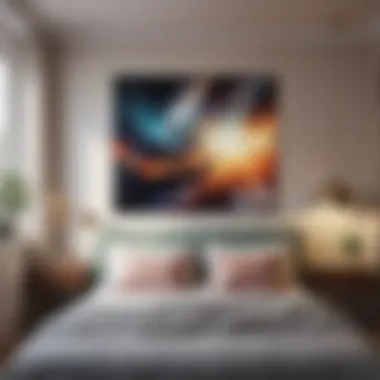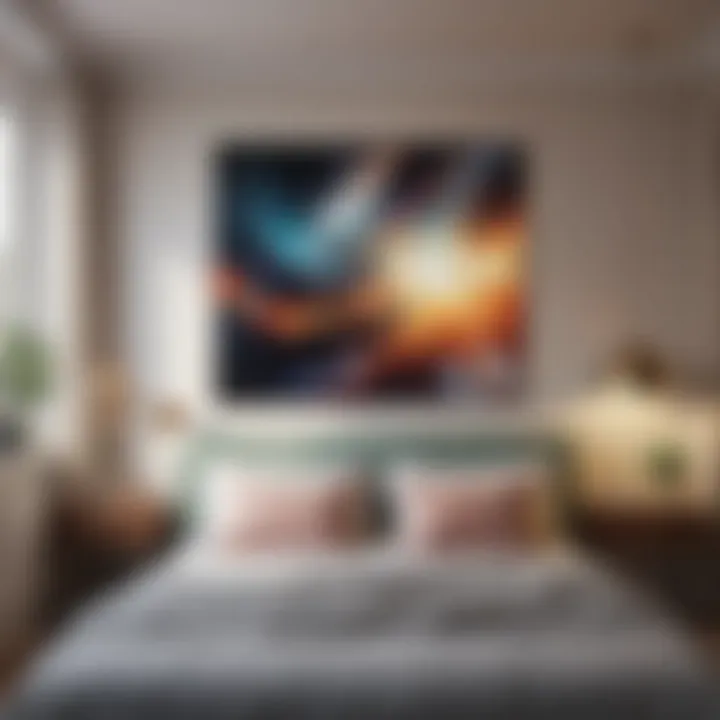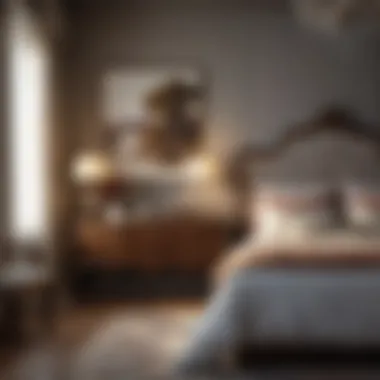Bedroom Art Design: Elevate Your Space


Intro
Creating a harmonized space in your bedroom involves more than just furnishing it with comfortable furniture. The art you choose to display plays a fundamental role in encapsulating not just the aesthetics but also the ambiance of the room. It's about syncopating your personal narrative with the visual language of art, taking you from a mundane space to a curated sanctuary.
The intersection of artistry and bedroom design is rich with potential. Selecting artwork that resonates with your personal style can transform not just the look but also the feel of your sleeping quarters. This guide will navigate through the myriad of styles available, examine the impact of color selection, and offer practical insights on achieving that cohesive look you desire. So, buckle up as we journey into the vibrant world of bedroom art design.
Trending Styles
When it comes to adorning your bedroom walls, knowing the trending styles can help in making informed decisions. Two styles that frequently come into focus are Modern Minimalism and Cozy Rustic.
Modern Minimalism
The mantra of less is more perfectly encapsulates the heart of Modern Minimalism. This style revolves around clean lines, discreet hues, and an uncluttered approach to art. A single, statement piece can often speak louder than a gallery wall cluttered with various images. Think about a large monochromatic painting or a simple abstract piece that harmonizes with your bedroom's color palette. Incorporating geometric shapes can bring a sophisticated touch while maintaining simplicity.
Cozy Rustic
On the contrary, Cozy Rustic brings warmth and character into the mix. Envision soft colors, earth tones, and textured artwork that invites comfort. Art pieces that feature landscapes, floral motifs, or vintage-inspired illustrations often embody this style. Perhaps consider using wooden frames or repurpose reclaimed materials to further accentuate a rustic vibe. The key is to find pieces that whisper warmth and enchantment, making your space feel inviting.
"Art is not what you see, but what you make others see."
— Edgar Degas
Color Palettes
Choosing the right color palette is crucial in art selection as colors influence mood and energy levels. Two contrasting avenues to explore are Calming Neutrals and Bold Accents.
Calming Neutrals
Calming Neutrals include shades of beige, gray, and soft whites that induce relaxation. When selecting artwork, you could look for pieces that incorporate pastel colors or gentle transitions of light and shadow. These artworks should accentuate the tranquil vibe of the room, ensuring that at the end of the day, your bedroom feels like a peaceful oasis.
Bold Accents
On the other hand, Bold Accents can inject a lively spirit into your space. Think bright reds, deep blues, or vibrant yellows. Incorporating pieces that splash these intense hues can evoke emotion and energy. However, it’s essential to strike a balance. Perhaps a large colorful canvas combined with muted décor can keep things lively yet grounded.
Preface to Bedroom Art Design
Art holds a significant position in home design, particularly in spaces meant for rest and rejuvenation. The bedroom, often a sanctuary, deserves careful consideration when it comes to selecting artwork. Integrating the right art into this personal space can transform it into a place of inspiration and tranquility, reflecting individual personalities and emotions.
Defining Bedroom Art Design
So, what does bedroom art design actually entail? It encompasses the selection and placement of visual art that resonates with the occupant's vibe and contributes to the room's overall aesthetic. It’s about more than just slapping a few paintings on the wall; it’s about creating a harmonious relationship between the artwork and the environment. This includes understanding the colors that evoke specific feelings, choosing styles that align with personal tastes, and placing pieces in ways that draw the eye and enhance the room’s flow.
When considering bedroom art design, one must think about:
- Personal style: What speaks to you? Is it modern art, photographs, or maybe something more rustic?
- Color harmony: Choosing pieces that match or complement the color scheme of the room can tie everything together.
- Scale: Bigger isn’t always better. Sometimes, a small piece can have a bigger impact depending on the context.
The Significance of Art in Personal Spaces
Art acts as a form of expression and storytelling. It can say a lot about a person’s interests, emotions, and experiences without uttering a word. For many, artwork in the bedroom is not merely decor; it forms a bridge to memories or aspirations. Maybe a landscape painting reminds one of a cherished vacation, or a vibrant abstract piece sparks creativity and positivity.
Moreover, placing inspiring or calming artworks throughout the bedroom can have a pronounced impact on one’s mood. As studies suggest, the visual environment we dwell in can greatly influence our mental states. Having artwork that resonates can foster an atmosphere of peace, rejuvenating the spirit after a long day. In essence, the right artwork can turn an everyday space into a beloved retreat.
"Art is the most beautiful of all lies." – Pierre-Auguste Renoir
Ultimately, art in the bedroom is more than just an accessory—it’s a vital component of personal design that enhances the quality of living. Choosing art wisely can elevate the mood of the entire room, merging function and aesthetics seamlessly.
Art Styles for the Bedroom
When it comes to personalizing a bedroom, selecting the appropriate art styles holds significant weight in shaping the overall ambiance. The essence of a bedroom is not just in the comfort it provides, but also in the feelings that artwork evokes. Choosing art that resonates with one's unique taste and the room's decor can create a peaceful sanctuary. This article presents various art styles suited for bedrooms, allowing individuals to find something that truly speaks to them.
Contemporary Art
Contemporary art is often characterized by its reflection of current society and its exploration of new mediums and technologies. In a bedroom context, this style can breathe life into stale spaces. Art like bold abstract paintings or installations using mixed media can create a striking focal point. The colors and forms often express emotions and ideas in ways that resonate personally.
For instance, a large canvas featuring vibrant geometric designs could inspire energy during the day and induce serenity at night. Likewise, minimalist pieces with soft lines and scattered colors can lend a calming, zen-like aura to the room. It's important to consider how contemporary art interacts with existing furniture and decor, as the right piece can tie the room together beautifully.
Abstract Pieces
Abstract art, with its emphasis on non-representational forms, allows for a broader interpretation, making it a great choice for a bedroom. This type of art provokes thought and permits personal connections. A splash of colors or unique shapes may evoke feelings that vary from viewer to viewer.
In a small bedroom, an oversized abstract piece can create an illusion of space while drawing the eye upwards. It's a clever trick that may make a room feel larger. On the other hand, smaller, thoughtful abstract artworks can be arranged together to create an intimate gallery wall that reflects individual experiences and memories.
Classic and Traditional Art


The charm of classic and traditional art lies in its timeless appeal. This genre often includes beautifully framed portraits, landscapes, and still life pieces that tell stories from a different era. Opting for such art in a bedroom brings an element of history and sophistication.
Furthermore, classic art can seamlessly blend with various design elements, from vintage furniture to modern decor. For those who appreciate rich detail and historical contexts, pieces by renowned artists like Claude Monet or Vincent van Gogh can transform a bedroom into a rendezvous with artistry.
If incorporating classic art into the bedroom, consider utilizing ornate frames to enhance the piece's visual weight. This approach often produces an elegant look that invites admiration.
Photography as Art
Photography has burgeoned into a prominent form of artistic expression. With the advent of high-quality prints and digital photography, it presents limitless opportunities for personal expression in bedroom decor. Selecting photographic art can evoke emotions connected to specific locations, moments, or themes.
For example, a panoramic photograph of a serene beach scene might provide a perfect tranquil backdrop for a relaxing atmosphere in the bedroom. Alternatively, candid portraits or black-and-white street photography can inject a lively narrative into the space.
Using various sizes and formats, from large-scale prints to smaller framed pieces, adds depth and a contemporary touch to the bedroom. A well-placed piece of photographic art pulls one into its narrative while harmonizing with the room’s overall theme.
"Art in a bedroom isn't just decoration; it’s a personal story waiting to be told."
In summary, the art styles chosen for a bedroom contribute much more than aesthetic value. They offer a means of personal expression and can create environments that enhance well-being and comfort. From contemporary flair to classic elegance or the captivating nature of photography, there exists a myriad of options to explore, making the journey of curating art for a bedroom both fulfilling and transformative.
Understanding Color Theory in Art
Color plays a pivotal role in the ambiance of any room, particularly in a personal retreat like the bedroom. By understanding color theory, homeowners can make more educated choices when selecting art that not only complements their preferences but also influences moods and feelings in their intimate space. Color theory touches on how colors interact, evoke emotions, and can be used strategically to create a desired atmosphere. This understanding can amplify the overall design, turning a standard room into a sanctuary tailored to individual needs.
The Psychological Effects of Color
Colors have a profound impact on our psyche. For example, shades of blue often elicit a sense of calm and tranquility, making it a popular choice for bedrooms. In contrast, bright colors like red can increase energy and passion, though they may not be as conducive to restful environments. Consider how purple can evoke creativity, yellow can inspire optimism, and how green can remind one of nature's balance and restoration.
Here are some common psychological effects of colors:
- Red: Often linked to passion; can increase heart rates.
- Blue: Associated with calm and stability; encourages relaxation.
- Green: A symbol of nature; promotes healing.
- Yellow: Signals happiness and cheer but can be too intense in large doses.
- Purple: Represents luxury and spirituality.
- White: Conveys purity and simplicity; can make a space feel larger.
Understanding these associations can guide homeowners in choosing art that reinforces the desired emotional tone of the bedroom.
Choosing the Right Palette
Selecting a color palette involves more than picking colors that look appealing side by side. It's about creating a cohesive flow that seamlessly integrates with the room's existing elements. For those curating a personalized art collection, it helps to consider the dominant hues already present, such as wall color, furniture finish, and textile patterns.
Here are some steps to consider when choosing your palette:
- Assess Existing Colors: Look around your room—note the existing colors of your walls, bedding, and furniture.
- Create a Cohesive Look: Opt for artworks that feature at least one color echoing existing tones to avoid clashing.
- Contrast and Balance: If your bedroom leans towards neutral shades, you might introduce pop colors through artwork to create vibrancy. On the flip side, in brighter rooms, softer pastels may complement the environment better.
- Experiment with Samples: Many paint suppliers offer sample pots. It's worthwhile to test small swatches next to artwork to see how colors play together under various lighting.
"The right colors can either highlight or diminish the impact of the artwork—it's all about balance and harmony."
By delving into color theory, homeowners can elevate their bedroom design beyond superficial choices, crafting a space that resonates with their personal tastes while fostering a serene atmosphere.
Creating Focal Points with Artwork
In the realm of interior design, creating focal points is akin to directing attention in a play; every piece of decor has its role, but some demand a spotlight. Artwork can transform a regular bedroom into an awakening sanctuary. When you strategically place art, you not only enhance the aesthetic appeal but also influence the emotional atmosphere of the space. By establishing a focal point, you're inviting an interplay of colors, textures, and themes that can elevate even the simplest room to a dreamy retreat.
The significance of a well-chosen artwork as a focal point lies in its ability to create balance and draw the eye. Think of it as a magnet that attracts attention. This can provide an anchor for the room and make all other design elements seem to fit naturally around it. Additionally, it sets a tone for the entire room; whether your goal is calm, vibrant, or cozy, the artwork plays a pivotal role in achieving this mood.
Identifying Ideal Locations
When considering where to hang your artwork, the primary question is often: "What’s the best spot?" While there are no hard and fast rules, certain guidelines can help pinpoint those ideal locations.
- Above the Bed: This is often the go-to choice. A large piece above the headboard can serve as a visual anchor and frame the bed as the centerpiece of the room. Consider how the piece aligns with bed linens and pillows to maintain a cohesive look.
- Opposite a Window: Placing art on the wall across from windows allows natural light to interact beautifully with your chosen pieces. The interplay can alter how colors appear throughout the day.
- Empty Walls: If there's a large, blank wall, that space is practically shouting for some creativity. A thoughtful display can transform that area, making it another talking point in your design.
- Nooks or Corners: Sometimes, a smaller piece in a cozy nook or corner can create an intimate atmosphere, making the space more inviting.
Complementing Furniture and Layout
Art in a bedroom shouldn't just stand alone; it should engage in a dialogue with the furniture and layout of the room. This harmonious relationship enhances the overall aesthetic and functionality of the space. Here are some considerations:
- Scale Matters: Consider the size of the furniture when choosing artwork. A tiny print can get lost among large furniture pieces, while oversized works may overwhelm smaller items.
- Matching Themes: If your furniture lean towards a minimalist style, a bold piece of abstract art can create a stunning contrast. Alternatively, for ornate furniture, classic artworks can nicely mirror the elegance.
- Color Coordination: Pull colors from nearby textiles—like curtains or cushions—and see if those hues can be found in your art. This subtly links various elements without appearing forced.
- Vertical vs. Horizontal Positioning: Taller pieces can give an illusion of height in a room, whereas horizontal artworks can make a space feel wider. Choose a style that complements your current layout.
In essence, every artwork has the potential to become a narrative, weaving together the various elements within the bedroom, ensuring a seamless blend of form and function.
"Art helps us to find ourselves and lose ourselves at the same time." - Thomas Merton
Creating a focal point with artwork is more than mere decoration; it is an opportunity to express individuality and transform a space into a reflection of personal style. Engaging thoughtfully with these aspects can result in a bedroom that not only looks stunning but also feels uniquely yours.
Harmonizing Artwork with Overall Design
Creating an inviting and cohesive bedroom environment is a nuanced task that goes beyond simply selecting a few pieces of artwork. Harmonizing artwork with the overall design is crucial to ensuring that every element in the room works together, adding to the intended ambiance. This process requires careful consideration of various aspects such as color schemes, styles, and textures in relation to each other. When done correctly, it transforms the bedroom into a serene and personalized retreat, making it a space where one can truly unwind.
A well-coordinated design begins with understanding how art interacts with other design elements including furniture, textiles, and lighting. When these components are aligned, they create a visual harmony that not only beautifies the space but also enhances the viewer's experience. For instance, a vibrant abstract painting can become the centerpiece of the room, bringing warmth and energy, while neutral textiles can allow the colors in the artwork to pop. This balance creates a sense of tranquility, essential for a bedroom.


"Art is not just a decoration; it is a reflection of you and can influence the emotions you experience in your private space."
Matching Art with Textiles
When it comes to matching art with textiles, one must consider the colors, patterns, and textures present in both. Textiles encompass all fabrics in the room—bed linens, drapes, cushions, and even accent chairs. Art pieces can amplify the elegance and comfort of textiles by mirroring their colors or by providing a contrasting element that draws the eye.
For example, a large canvas featuring soft pastels can complement elegantly textured pillows with similar hues, weaving a consistent palette throughout the bedroom. This creates not only a visual connection but also a tactile experience as one moves through the space. On the other hand, if the room boasts bold textiles, such as a patterned quilt or vibrant curtains, art can serve as a grounding force. Choosing a simple, monochromatic piece can enhance the room’s energetic vibe without overwhelming it.
Important considerations when matching art with textiles include:
- Color Coordination: Aim for a balanced color scheme that either harmonizes with or contrasts against the existing textile palette.
- Texture Play: Use artwork with textures that either echo or provide variety to the textiles, such as a textured canvas to accompany soft throws.
- Theme Consistency: Ensure that both art and textiles complement the broader theme of your space, whether that’s minimalist, bohemian, or classic.
Integrating Art with Room Lighting
The relationship between art and lighting cannot be overstated. The way a piece of art is illuminated can drastically alter its presence and the feel it evokes in the room. Proper lighting not only highlights the artwork but also interacts with the colors and materials present, enhancing their visual appeal.
For instance, using spotlights or adjustable wall sconces to illuminate a painting can create shadows and highlights that add depth and interest. Natural light is equally important; large windows can provide an evolving backdrop, changing how artworks are perceived at different times of the day. However, it's also essential to consider the potential for fading—some artworks may not be suited for direct sunlight.
When integrating art with room lighting, keep these factors in mind:
- Ambient Lighting: Overall room lighting sets the tone. Warm-toned bulbs may bring out earthier shades in art.
- Task Lighting: Focused lights over reading nooks can double as a spotlight for smaller art pieces placed strategically.
- Accent Lighting: Use accent lights to highlight your favorite pieces, allowing them to stand out without disrupting the overall design.
By thoughtfully harmonizing artwork with the overall bedroom design, one enhances not just the aesthetic but also the emotional and psychological comfort of the space. This careful balancing act makes it a sanctuary that reflects personal style while also encouraging relaxation and creativity.
Displaying Artwork in the Bedroom
Displaying artwork in a bedroom transcends mere decoration; it serves as a bridge between personal expression and the ambience of one's retreat. Choosing the right pieces and arranging them wisely can transform a dull space into a sanctuary of comfort and inspiration. Art has the unique ability to resonate with memories and emotions, and when one steps into their bedroom, this space should reflect personal stories, aspirations, and the overall tone one wishes to cultivate in this intimate environment.
Framing Options and Techniques
Selecting the right frame goes beyond protecting the artwork. It can enhance the piece, drawing attention to its details or harmonizing with the bedroom’s decor. Some popular framing options include:
- Classic Wood Frames: These provide a timeless look and can suit various art styles.
- Floating Frames: They create a modern feel, allowing the artwork to seemingly float within the frame, often used for photography or lightweight art.
- Gallery Frames: This offers a more polished and professional look when displaying collections of artworks.
- Custom Frames: Tailored frames can match specific room aesthetics or personal preferences, albeit at a higher cost.
When considering what frame to choose, think about the colors and textures around the room. For example, bright and playful art might deserve a lighter, quirky frame that adds to its energy, whereas more subdued pieces may benefit from darker, sleek frames to ground them.
Gallery Wall Ideas
Creating a gallery wall is a captivating way to showcase multiple artworks, and it can be as creative or structured as the individual desires. Here are some ideas:
- Themed Collections: Choose artworks connected by a certain theme—be it color, subject matter, or style. This creates visual harmony and tells a coherent story.
- Mix and Match: Combine different sizes, textures, and styles for an eclectic look. This technique showcases personal flair and spontaneity.
- Symmetrical Arrangements: A more formal approach, where photos and prints are arranged in a neat grid, can evoke elegance. Visual balance in this scenario is key.
- Framed Textiles: If photographs or paintings don’t suit the vibe you seek, consider framing unique fabrics. This method adds texture and interest.
A well-thought-out gallery wall can turn an empty space into a vibrant focal point. Arranging pieces at eye level is generally most effective, ensuring they are seen and appreciated.
Alternative Display Methods
Exploring various methods to display artwork can keep the aesthetic fresh while maximizing creativity. Some alternative options include:
- Floating Shelves: Utilizing shelves allows the flexibility to change out artwork whenever inspiration strikes without damaging walls.
- Clips and Wire: A simple wire strung between two points with clips can create an informal presentation that showcases rotating images or art pieces. It’s also easy to refresh regularly.
- Easels: Utilizing easels can add unexpected flair, especially for larger pieces or canvases. They work well in corners, bringing a gallery-like vibe without committing to permanent fixtures.
- Art on Door Panels: An often-overlooked space, painting or adhering art to the backside of door panels can surprise and delight when opened.
Art allows room for personality to shine through, making practical space-seizing methods an effective way to engage viewers and enhance daily experiences in your bedroom. The goal is to cultivate an environment that resonates with you, merging form and function seamlessly.
"Art enables us to find ourselves and lose ourselves at the same time." - Thomas Merton
Displaying artwork in the bedroom is not just about aesthetics. It’s about curating a personal haven—one that provides comfort, encouragement, and perhaps even a spark of creativity each time you enter. It reminds us that home is indeed where the art is.
Balancing Art with Other Design Elements
Balancing art with other design elements in a bedroom setting is not just a matter of aesthetics; it’s about creating a space that resonates with personal style while also fostering a calming atmosphere. This balance can transform a room from merely functional into a retreat that reflects individuality and comfort. By carefully selecting and positioning artwork in relation to lighting, furniture, and overall design themes, homeowners can achieve a harmonious ambiance that feels cohesive and inviting.
The Role of Lighting in Art Display
Lighting is a crucial component in showcasing art within the bedroom. A well-lit piece can dramatically enhance its visual impact, making the colors pop and highlighting the texture of the artwork.
- Consider Natural Light: Take advantage of the natural light that the room receives. Positioning art pieces near windows where sunlight can wash over them adds an element of life and vibrancy.
- Accent Lighting: Incorporate accent lighting, such as wall sconces or spotlights. These can focus light on the artwork, acting as a spotlight that draws the eye. The use of dimmers can allow for flexibility, adjusting the mood of the room as needed.
- Layered Lighting: Utilize a combination of overhead, task, and ambient lighting. Layered lighting not only aids in illuminating the art but also creates depth, enhancing the entire aesthetic of the space.
The secret to effective lighting lies in its ability to change the perception of the artwork, making it feel integral to the room rather than an afterthought.
Art and Furniture Synergy
The relationship between art and furniture cannot be overstated. They should not compete for attention but rather complement one another, creating a unified look. This synergy involves considering various aspects:


- Scale: Ensure that the size of the artwork corresponds well with the furniture pieces. A large canvas above a modest bed could either enhance the space or overpower it. Conversely, small artworks may get lost on vast walls.
- Style: The styles of the furniture and art should align. For instance, sleek, contemporary furniture pairs well with abstract pieces, while ornate or vintage furniture finds its match in classic paintings.
- Color Coordination: Choose artworks that reflect or echo the color palette of the furniture. This ties everything together and creates a visual rhythm that’s easy on the eyes, making the room feel more tailored and finished.
Maintaining Cohesiveness with Design Themes
Cohesiveness in design themes speaks to the essence of a well-designed bedroom. When art aligns with the broader design narrative, it can set the tone for the entire space. Here are some strategies to consider:
- Define a Theme: Start by defining a specific design theme for the room. Whether it's modern minimalism, rustic charm, or bohemian elegance, the art should resonate with this theme.
- Consistent Motifs: Use motifs or subjects in art that reflect other elements within the room. For instance, if botanical prints are prevalent in the bedding or curtains, select art that features similar natural themes.
- Textural Balance: Incorporate artwork that balances the textures present within the room. If the furniture is predominantly smooth and sleek, consider adding paintings with heavier textures or mixed media to add interest.
Curating a Personalized Art Collection
Curating a personalized art collection is not just about gathering artwork; it is about creating a space that reflects who you are and what you love. This process can be particularly enriching because it gives you control over the aesthetic of your bedroom, tying together elements of your personality and creating a sanctuary that feels truly yours. The right collection can enhance the atmosphere, spark joy, and even serve as a conversation starter when guests drop by. When art resonates with you, it can make your space feel more inviting and meaningful.
Identifying Personal Taste
The first step in curating art is figuring out your personal taste. This can often feel like a daunting task, but it doesn’t have to be. Start by reflecting on what makes your heart flutter. Look at different genres—be it modern, classical, or even quirky art forms—and notice what catches your eye.
Consider keeping an inspiration board, whether physical or digital, where you can pin images of artworks that resonate with you. Tools like Pinterest can be quite useful for this. As you collect these images, seek patterns in style, color, and subject matter. Are you drawn to landscapes, abstract art, or perhaps portraits of people? Your favorites can illuminate a clear path toward the kind of art that would feel just right in your bedroom.
Also, don’t forget about personal experiences and memories. Sometimes, a particular piece can remind you of a special moment or a loved one. These emotional connections can make your art collection feel even more intimate.
Budget Considerations for Art Acquisition
When diving into the world of art, especially for your bedroom, budget undoubtedly plays a crucial role. It should not limit your vision but rather guide your choices. Art can range from affordable prints to original masterpieces from renowned artists, so finding a way to balance what you love with what you can afford is key.
One way to approach this is by setting a budget beforehand. Ask yourself: how much are you comfortable spending? Consider the long-term investment potential of unique pieces versus inexpensive prints that might not last as long.
- Inexpensive options: Look for local artists, galleries, or even online platforms where you may find affordable art without compromising quality. Websites like Etsy or local arts and crafts fairs can be a great starting point.
- Support emerging artists: Investing in pieces from up-and-coming artists can bring fresh talent into your home and often for a lower price.
- Consider reproductions: High-quality reproductions can be a budget-friendly way to get pieces from your favorite artists without breaking the bank.
Ultimately, it’s important to choose pieces that resonate with you, even if they are not the most expensive or trending. Remember, art isn’t about the price tag; it’s about the connection you form with it.
"Art enables us to find ourselves and lose ourselves at the same time." - Thomas Merton
By combining your personal taste with sensible budgeting, you can gradually build an art collection that speaks to your soul while fitting into your financial landscape.
Maintaining and Caring for Bedroom Art
Taking care of artwork in your bedroom is not just about having pretty decorations; it's about fostering and preserving the spirit behind those pieces. Art can evoke emotions and memories, creating an atmosphere that resonates with personal experiences. Thus, maintaining and caring for bedroom art is essential to keep it looking its best and to ensure its longevity. Not only does this sustain the aesthetic appeal, but it also protects the investment made in acquiring these artworks.
Here are some considerations and benefits regarding maintaining art:
- Longevity: Proper care ensures that colors stay vibrant and materials do not degrade.
- Investment Protection: If you've invested significant money in your art, maintaining it can help retain its value.
- Emotional Connection: Well-maintained artwork can continue to evoke the same emotions it provided when you first acquired it, reinforcing its significance in your home.
Overall, taking the time to look after your art speaks volumes about how much you value your home spaces and the moods they create.
Cleaning and Preservation Techniques
Cleaning artwork may seem simple; however, it involves a nuanced approach tailored to different materials. Here are some valuable tips:
- Dust Regularly: Use a soft, dry cloth or a feather duster to gently remove dust. It's best to keep a routine, perhaps once a month.
- Avoid Harsh Cleaning Agents: Using soap and water can be beneficial but ensure that it's meant for art. Abrasive or caustic cleaners can ruin the surface of the piece.
- Framed Works: For framed art, ensure the front glass is cleaned separately with a gentle glass cleaner. Check the frame for any loosening or damage over time.
- Humidity Control: Excess moisture can be a killer for art, especially canvas and watercolors. Aim to keep the humidity below 60% in the room to minimize risks.
"Regular maintenance can transform your bedroom artwork from a fleeting decoration to a cherished piece for years to come."
Storing Artworks Properly
When it comes to storing artwork, whether during a move or seasonal changes, proper methods should be followed to prevent damage:
- Flat Storage: If you must store flat artworks, lay them flat and separate each piece with acid-free paper. This prevents scratching and transfer of oils.
- Vertical Storage: For those who prefer vertical options, make sure not to lean pieces against one another. Consider using a rack designed for art to keep everything organized.
- Avoid Attics and Basements: Given their fluctuating temperatures and humidity levels, these areas are not suitable for storing valuable pieces. Choose a temperature-regulated room instead.
- Wrap with Care: When storing, wrap the artworks in bubble wrap or foam sheets, ensuring that you cushion the corners for extra protection. Avoid plastic covers as they can trap moisture.
By keeping your artworks clean and stored properly, you help preserve not just the physical piece but also its story and the place it holds in your life.
The End and Final Thoughts
Art in the bedroom is not merely a decor choice; it holds significant weight in shaping the environment and even the emotional well-being of those who inhabit the space. From the very first moment you set foot in a bedroom adorned with meaningful artwork, there's a profound impact that transcends aesthetics. Choosing the right pieces can foster a sense of calm, provoke thought, and ultimately create a sanctuary.
The Lasting Impact of Art in the Bedroom
When people walk into a bedroom, they often feel the ambiance conditioned by various elements, and art plays a pivotal role in this.
- Emotional Resonance: Artwork can evoke various feelings. A serene landscape might usher in tranquility, while vibrant abstracts might stimulate creativity or energy. The emotional tie to the pieces displayed makes the space intimate and personal.
- Visual Storytelling: Each piece of art is a story waiting to be told. Incorporating images or styles that reflect life experiences, travels, or personal growth can transform a mere room into a narrative of one’s journey. This creates a reflective environment that encourages personal growth.
- Cohesion and Balance: Strategically placed artwork can round off a room's design. It creates harmony with other elements—be it furnishings, textiles, or colors. It shapes the overall aesthetic as well, ensuring that the bedroom feels complete.
"Art is not what you see, but what you make others see." — Edgar Degas
Encouraging Personal Expression through Art
Choosing artwork for a bedroom can be seen as an extension of one's personality. This is where personal expression comes to the forefront, allowing individuals to create a space that truly reflects who they are.
- Showcasing Identity: Every individual has unique tastes and experiences. Selecting art that echoes personal interests—whether it's abstract art, landscapes, or black-and-white photography—allows the bedroom to embody one's character.
- Creating a Narrative: Art provides a platform for telling one's story. Perhaps it's a painting from a beloved vacation spot or a print that reflects a passion for nature. These pieces invite visitors into your world, offering glimpses into the life lived beyond the four walls of the bedroom.
- Fostering Connection: When art resonates on a personal level, it promotes a strong emotional connection, not just for the owner but also for friends and family who enter the space. This connection turns the bedroom into a haven where thoughts and feelings can flourish, unchecked by external judgment.
In summary, the art in a bedroom has far-reaching implications. It goes beyond mere decoration and becomes a vital component of personal expression and emotional sustenance. It encourages homeowners to engage with their surroundings and express individuality, ensuring their bedrooms remain sanctuaries of personal values and experiences.















